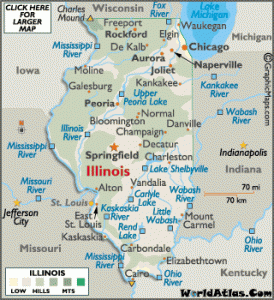Illinois
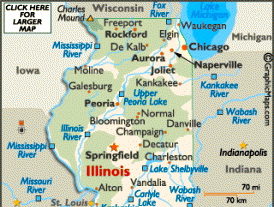
Warsaw Illinois History
This is a video I did for a class as Western Illinois University detailing the begginning of a small river town in Illinois along the banks of the Mississippi River.
- (1673) French explorers Jacques Marquette and Louis Jolliet arrived in Illinois
- (1675) Marquette founded mission at Great Village of the Illinois
- (1680) French traders Rene Robert Cavelier, the Sieur de La Salle and Henry de Tonty built Fort Crevecoeur on Illinois River; Iroquois Indians destroyed Great Village
- (1682) La Salle, Tonty built Fort St. Louis across Illinois River from site of Great Village
- (1699) Cahokia founded, oldest town in Illinois
1700’s
- (1717) Illinois part of French colony of Louisiana
- (1720) Fort de Chartres became seat of civilian, military government in Illinois
- (1730) French troops, Indian allies in central Illinois massacred Fox Indians
- (1754 – 1763) French Indian War
- (1763) French Indian War ended, Illinois ceded to Britain in Treaty of Paris
- (1769) Illinois Indians besieged, starved at Fort St. Louis(now Starved Rock)
- (1778) George Rogers Clark defeated British at Kaskaskia
- (1787) Illinois became part of Northwest Territory
1800’s
- (1800) Illinois included in Indiana Territory
- (1803) Kaskaskia Indians ceded nearly all Illinois lands to U.S.; U.S. Army established Fort Dearborn
- (1804) Lewis and Clark expedition started near
Wood River - (1809) Congress created Illinois Territory
- (1811) First coal mine in Illinois opened in Jackson County; parts of southern Illinois damaged by New Madrid earthquake
- (1812) Potawatomi Indians destroyed Fort Dearborn, massacred 52 troops and civilians
- (1817) Veterans of War of 1812 received 160-acre land warrants in Illinois Military Tract between Illinois and Mississippi Rivers
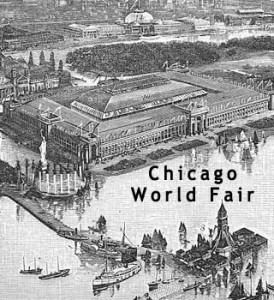 (1818) Illinois became 21st U. S. state, Kaskaskia chosen as capital
(1818) Illinois became 21st U. S. state, Kaskaskia chosen as capital- (1819) Kickapoo Indians moved west of Mississippi, ceded most of their lands in central Illinois
- (1820) Vandalia became state capital
- (1823) Galena became lead mining center
- (1824) Constitutional convention call to permit slavery defeated by voters
- (1829) Potawatomi, Ottawa, Chippewa Indians ceded
- (1830) Abraham Lincoln moved to Illinois; first state prison built at Alton
- (1837) Chicago incorporated as city; pro-slavery mob murdered abolitionist editor, Elijah P. Lovejoy at Alton; John Deere designed self-scouring steel plow
- (1839) National Road completed from Cumberland, Maryland to Vandalia; Springfield became state capital; Cherokee Indians passed through southern Illinois on “Trail of Tears”
- (1844) Mormon leaders, Joseph and Hyrum Smith, assassinated at Carthage by anti-Mormons
- (1846) Mormons left Illinois for Utah
- (1847) Cyrus Hall McCormick opened plant in Chicago for manufacturing wheat reapers
- (1848) Chicago Board of Trade organized; Illinois & Michigan Canal completed
- (1853) Legislation enacted by General Assembly to prevent free blacks from setting in Illinois
- (1855) Free public school system adopted
- (1856) First railroad bridge across Mississippi River completed between Davenport, Iowa and Rock Island
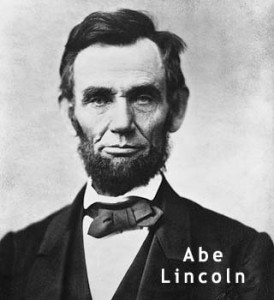 (1860) Abraham Lincoln elected U. S. President
(1860) Abraham Lincoln elected U. S. President- (1861) Civil War began; Cairo became troop, supply center for Union Army
- (1864) Lincoln reelected U.S. President
- (1865) Illinois first state to ratify Thirteenth Amendment abolishing slavery; Lincoln assassinated in Washington, D.C., buried in Springfield
- (1867) George M. Pullman founded Pullman Palace Car Company in Chicago, manufactured railroad sleeping cars
- (1868) Ulysses S. Grant elected U. S. President
- (1871) Chicago fire destroyed 18,000 downtown buildings, $200 million estimated losses
- (1883) First compulsory school attendance legislation enacted by General Assembly; world’s first skyscraper, Home Insurance Building, designed in Chicago
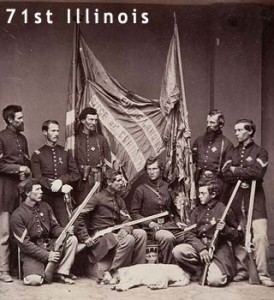 (1886) Riot and bombing in Chicago at Haymarket Square during labor rally
(1886) Riot and bombing in Chicago at Haymarket Square during labor rally- (1892) Myra Bradwell, Chicago attorney, first woman admitted to practice before U. S. Supreme Court; Adlai Stevenson I elected U. S. Vice President
- (1893) World’s Fair held in Chicago
- (1894) Strike at Pullman factory in Chicago became national railway strike; federal troops called in to control mob violence
- (1898) United Mine Workers won labor disputes after 11 miners, guard killed at Pana and Virden
- (1890) Frank Lloyd Wright established studio in Oak Park to design prairie-style architecture
The history of Illinois may be defined by several broad historical periods, namely, the pre-Columbian period, the era of European exploration and colonization, its development as part of the American frontier, and finally, its growth into one of the most populous and economically powerful states of the United States.
Pre-Columbian era
Cahokia, the urban center of the pre-Columbian Mississippian culture, was located near present-day Collinsville, Illinois. That civilization vanished circa 1400–1500 for unknown reasons. The next major power in the region was the Illiniwek Confederation, a political alliance among several tribes. The Illiniwek gave Illinois its name. The Illini suffered in the 17th century as Iroquois expansion (caused by European expansion in the eastern United States) forced them to compete with several tribes for land. The Illini were replaced in Illinois by the Potawatomi, Miami, Sauk, and other tribes.
European exploration and colonization
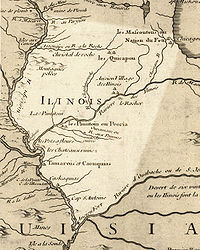 Illinois in 1718, Guillaume de L’Islemap, approximate state area highlighted.
Illinois in 1718, Guillaume de L’Islemap, approximate state area highlighted.
French explorers Jacques Marquette and Louis Jolliet explored the Mississippi and Illinois Rivers in 1673. As a result of their exploration, the Illinois Country was part of the French empire until 1763, when it passed to the British. The area was ceded to the new United States in 1783 and became part of the Northwest Territory.
American Territory
The Illinois-Wabash Company was an early claimant to much of Illinois. The Illinois Territorywas created on February 3, 1809. Illinois saw the construction of numerous civilian forts during the War of 1812, as well as the short-lived Fort Johnson.
Statehood
On December 3, 1818, Illinois became the 21st U.S. state. Early U.S. settlement began in the south part of the state and quickly spread northward, driving out the native residents. In 1832, some Indians returned from Iowa but were driven out in the Black Hawk War, fought by militia.
Illinois is known as the “Land of Lincoln” because it is here that the 16th President spent his formative years. Chicago gained prominence as a lake and canal port after 1848, and as a rail hub soon afterward. By 1857, Chicago was the state’s dominant metropolis. (see History of Chicago).
Slavery
The state has a varied history in relation to slavery and the treatment of African Americans in genera The French had black slaves from 1719 to as late as the 1820’s. Slavery was nominally banned by the Northwest Ordnance, but that was not enforced. But when Illinois became a sovereign state in 1818, the Ordnance no longer applied, and there were about 900 slaves there. As the southern part of the state, known as “Egypt,” was largely settled by migrants from the South, the section was hostile to free blacks and allowed settlers to bring slaves with them for labor. Proslavery elements tried to call a convention to legalize slavery, but they were blocked by Governor Edward Coles who mobilized anti-slavery forces, warning that rich slave owners would buy up all the good farm lands. A referendum in 1823 showed 60% of the voters opposed slavery, so efforts to make slavery official failed. Nevertheless, some slaves were brought in seasonally or as house servants as late as the 1840s. The Illinois Constitution of 1848 was written with a provision for exclusionary laws to be passed. In 1853, state senator John A. Logan helped pass a law to prohibit all African Americans, including freedmen, from settling in the state. After 1865 Logan reversed positions and became a leading advocate of civil rights for blacks.
Mormons at Nauvoo – Main articles: History of the Latter Day Saint movement and History of Nauvoo, Illinois
In 1839, members of the Church of Jesus Christ of Latter Day Saints, also known as Mormons, created a settlement they called Nauvoo. The city, situated on a prominent bend along the Mississippi River, quickly grew to 12,000 inhabitants, and was for a time rivaling for the title of largest city in Illinois. By the early 1840s, the LDS church built a large stone temple in Nauvoo, one of the largest buildings in Illinois at the time, which was completed in 1846. In 1844, the founder of the Latter Day Saint movement Joseph Smith, Jr. was assassinated in nearby Carthage, Illinois, even though he was under the protection of Illinois judicial system, with assurances of his safety from then Governor Ford. In 1846, the Mormons under Brigham Young left Illinois for what would becomeUtah, but what was still then Mexican territory. A small breakaway group remained, but Nauvoo fell largely into abandonment. Nauvoo today has many restored buildings from the 1840’s.
American Civil War – Main article: Illinois in the American Civil War
During the Civil War, over 250,000 Illinois men served in the Union Army, coming 4th in the states. Starting with President Lincoln’s first call for troops and continuing throughout the war, Illinois sent 150 infantry regiments; they were numbered from the 7th IL to the 156th IL. Seventeen cavalry regiments also served as well as two light artillery regiments. The most well worked soldier was Ulysses S. Grant of Galena. Throughout the war the Republicans were in control, under the firm leadership of Governor Richard Yat. The Democrats had a strong Copperhead element that opposed the war and tried in local areas to disrupt the draft. In Chicago, Wilbur F. Storey made his Democratic newspaper the Chicago Times into Lincoln’s most vituperative enemy.

